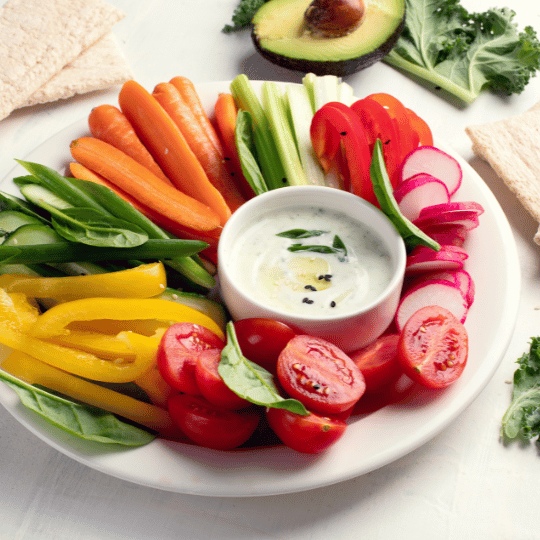How To Start Eating Healthy Without Stressing Yourself Out

In a world crammed with fast-food chains, microwave dinners, and sugar-loaded treats, figuring out how to transition to a healthy eating regimen can seem complicated.
We often equate eating well with sacrificing taste and convenience, leading many of us to sabotage our nutritional goals. But what if I told you that you could seamlessly ease into a healthier diet without radical changes or tasteless meals?
This post is tailor-made for those eager to overhaul their eating habits but unsure where to start. I will break down the steps that helped me switch to a healthier diet with easy-to-follow steps that you can take without feeling overwhelmed. Continue reading for practical tips on how to make healthy choices.
1. Follow a Healthy Eating Plan
The first step in any healthy eating transition is to have a plan. This doesn’t mean you need to meticulously count calories or shop for obscure ingredients. Simply setting out some guidelines can go a long way.
Start by aiming to fill half your plate with fruits and veggies, a quarter with whole grains, and a quarter with lean proteins. Add a serving of healthy fat and a portion of dairy if you consume it. This is the recommendation of the USDA MyPlate website.
Planning and cooking your meals at home will give you much more control over what you’re eating. This plan isn’t about deprivation; it’s about setting the stage for a nutritious and rewarding culinary experience.
2. Eat More Fruits and Vegetables
Fruits and vegetables are powerhouses of nutrition. They’re packed with vitamins, minerals, and antioxidants, all of which are essential for maintaining a healthy body. When you’re transitioning to a healthier diet, aim to incorporate more of them into your meals.
Snack on carrots and hummus or a piece of fruit when you’re craving something sweet. Try adding vegetables to your breakfast by throwing some spinach into your omelet or slicing peppers to dip in salsa.
3. Pick Whole Grains
Switching from refined grains to whole grains can have a profound impact on your health. Whole grains are higher in fiber and other nutrients, which promote digestive health and can help prevent chronic diseases.
Start by swapping white bread for whole-grain bread, white rice for brown rice, and regular pasta for the whole-grain variety. The taste and texture may be a little different, but the nutritional payoff is worth it.

4. Choose Healthy Fats
Not all fats are created equal. Some—like the ones found in olive oil, avocado, and nuts—are good for you, while others—like trans fats and saturated fats—can contribute to heart disease.
When watching your fat intake, focus on reducing the unhealthy fats while still including the healthy ones in your diet.
Read labels and be on the lookout for hidden fats in processed foods. Opt for grilling, baking, or steaming over frying, and choose lean cuts of meat.
5. Choose Lean Protein
Protein is an essential part of any healthy diet. It helps to build and repair tissues, make enzymes, and support an active immune system. When trying to eat healthier, choosing lean protein sources is important to minimize your intake of unhealthy fats.
Fish, chicken, turkey, beans, lentils, and cottage cheese are all excellent sources of protein that can easily be incorporated into your diet. If you eat red meat, choose lean cuts and eat them in moderation.
6. Reduce Sodium Intake
For many, lowering their sodium intake often conjures an image of bland dishes and joyless meals. However, reducing salt doesn’t have to mean a lack of flavor — it’s all about being smart with your choices.
Excessive sodium is linked to many health issues, from high blood pressure to heart disease, so cutting down is a vital step in maintaining good health. Tips to reduce your sodium intake: limit your consumption of processed foods, use herbs and spices to flavor foods, and choose low-sodium products. Visit Heart.org for more information.
7. Tracking Your Meals
Keeping a food diary is a simple but effective way to stay on track with your healthy eating goals. It can help you become more aware of what you’re eating, identify areas for improvement, and make better food choices.
There are plenty of apps and websites that make meal tracking easy and can even calculate the nutritional content of your meals. Tracking your meals doesn’t have to be a lifelong commitment; it’s just a tool to help you get started and stay accountable.

8. Taking Baby Steps
One of the biggest mistakes people make when trying to eat healthier is attempting a complete overhaul of their diet all at once. This can be overwhelming and often leads to giving up on the new eating habits altogether.
Instead, focus on making small changes that you can stick with. For example, you might start by swapping out your afternoon soda for a glass of water with a squeeze of lemon. Once you’re used to that, you can move on to the next change, like having a side salad with your dinner every night.
9. Setting Realistic Goals
Setting unrealistic goals is a surefire way to set yourself up for failure. Instead of saying you will completely cut out all processed foods or never eat dessert again, set small, achievable goals.
Maybe you’ll aim to cook dinner at home three nights a week or start your day with a healthy breakfast every morning. These small goals can add up to big changes over time and are much more sustainable in the long run.
Final Thoughts
Learning how to start eating healthy doesn’t have to be a drastic or painful process. By focusing on a few simple principles and making gradual changes, you can transform your eating habits without feeling deprived.
Remember, it’s not about being perfect; it’s about making the best choices and continually striving for improvement. With time and persistence, these changes will become second nature, and you’ll wonder how you ever lived any other way.







Great tips. I’ve been reducing my sodium intake and incorporating more fruits and veggies in my diet. Thanks for sharing!
Thank you! Making those changes can make a big impact.
I found this article to be most helpful. All to often I think I am too busy to eat healthy – but you’ve laid out a clear and achievable path for the easy changes I can make. Thank you!
I am so happy you found it helpful. It is easier to stay consistent with a plan that is doable.
These are really helpful tips on the journey of eating healthy. Setting realistic goals is such a great idea.
Thank you! It makes it less stressful and helps with staying consistent.
This is such a great guide to eating healthier, I have been trying to add lean and higher protein because I work out during the week I struggle with it though.
I am happy you enjoyed it! Sometimes it can be hard especially when working. Higher protein snacks or shakes have helped me. I have also added low fat cottage cheese to my egg beaters in the morning and that gave me a protein boost.
These are helpful tips for eating healthy. I’m working on eating more fruits and vegetables, choosing healthy fats, and reducing my sodium intake in my diet.
I love these tips! I find myself changing things one by one and this way keep them in my routine so definitely taking baby steps is recommended.
I am glad you liked the tips! Baby steps are important for long term consistency, it has helped me tremendously.
I love all these tips! I have been trying to eat healthier this year and I’m going to start implementing these tips. I love the idea of adding fruits and veggies to each meal. Thank you so much for sharing
I am so happy you found them helpful! It can be challenging when starting out.
These are very great tips for eating healthy. It can be overwhelming knowing where to begin, but you highlighted so many easy and great ideas!
I’m glad that you found the tips helpful! Starting a healthy eating journey can indeed feel overwhelming. Taking small, manageable steps helps with getting started and consistency, though. Thank you for your comment!
Great, practical tips on how to start eating healthy without feeling stressed! Thanks for sharing.
I appreciate you sharing this informative piece. I’m now actually tracking my meals and eating more fruits, vegetables, and whole grains.
great tips
After the Easter holidays, this is the perfect read haha 🙂
I really needed this post, thank you. It’s stressful to eat healthy when you’re so busy.